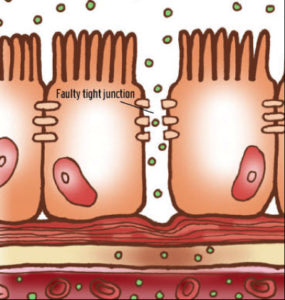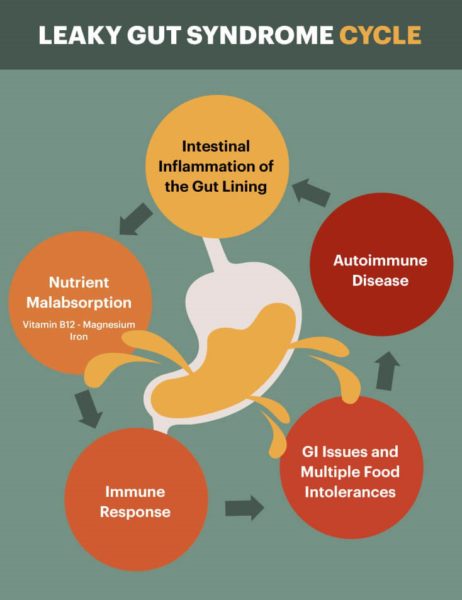Time to Heal and Seal That Leaky Gut?
Our gut is destined for greatness. It is responsible for so many different aspects of our health, so we have to ensure we look after it to the best of our ability; it deserves to be worshipped.
It’s a no-brainer that all of us here at Kultured Wellness HQ worship the oh holy gut. However, there is a difference between the almighty holy gut and a downright holey gut.
Leaky gut, or intestinal permeability, is quite simply cracks, leaks or holes within our gastrointestinal lining that are not meant to be there. These holes not only cause inflammation, they also allow translocation of gastrointestinal contents such as partially digested food and bacteria through the gastrointestinal wall. Imagine a stocking, pulled firm, has a nice, close, intricate weaving; this is how a gut lining should be. Now imagine a stocking, pulled firm, that’s full of ladders; that is like a leaky gut. No one wants to wear stockings full of ladders.
Gut Anatomy
Just like all matter within the human body, the gastrointestinal tract (GIT) is put together like a wondrous piece of art painted by Picasso. Science is still not aware of the full potential the human gut has on our overall health. However, science does know the biology of the gut and how it is put together.
The GIT consists of a hollow muscular tube starting at the mouth, where food is consumed, continuing through the pharynx, oesophagus, stomach and intestines to the rectum and anus, where food is expelled. Yay for science. There are various accessory organs that assist the tract by secreting enzymes to help break down food into its component nutrients. Thus the salivary glands, liver, pancreas and gallbladder have important functions in the digestive system and support the GIT. Although different sections of the GIT have slightly different functions, the entire tract has a similar structure – it is lined by a single layer of epithelial cells, often referred to as the mucosa, that is supported by an under or outer layer, often referred to as the submucosa, that consists of a selection of muscle, fat, and glands, depending on the exact anatomical location in the GIT (1).
The Intestinal Epithelial Cells (IEC) is what makes boundaries between the inner lumen of our GIT and its external surrounding environment (2). These cells are like best friends - they like to remain close and hold hands. By ‘holding hands’ they actually form tight junctions (3). These junctions basically see them attach to one another using protein strands to strengthen their bond and ‘tighten their weaving’, just like an intact stocking.

One role of our gastrointestinal epithelial cells and their collective tight junctions is to absorb and ‘allow’ small micro molecules, such as digested food particles, into circulation for use as a fuel source and other bodily processes. Another one of their tasks is to act as a barrier and to prevent the absorption of larger molecules such as undigested food particles, toxins and bacteria into circulation and allow them to be excreted with stool and other waste.
When our epithelial cells are healthy and our tight junctions are, well…tight, there should be no issues at all with them doing their correct job. However, more often than not these days, our tight junctions are just not that tight and they are unable to keep on top of their job descriptions.
Becoming Leaky
The problem with intestinal permeability, or lazy tight junctions, is that there is not one clear-cut cause. It can occur from a variety of reasons, some acute and sudden, however more often than not, it is caused by a variety of slow and insidious mechanisms that ultimately degrade the function of our GIT over time.
|
Causes |
Mechanism |
|
Dental Issues |
Painful, missing teeth cause us not to chew our food properly, which can ultimately lead us to not digest our food to the correct particle size leading to gut inflammation and irritation. |
|
Inadequate Stomach Acid |
Stomach acid is required for proper digestion of our food before it heads further down south. |
|
No Gall Bladder |
Our gallbladder is vital for digestion and storing our bile. Without a gallbladder, acidic bile can leak into the lower segments of our GIT causing irritation and inflammation. |
|
Diabetes |
Our pancreas, as well as regulating our insulin and blood glucose, houses beneficial digestive enzymes, and when these are not secreted correctly we are unable to digest our food properly. |
|
Food Intolerances/Allergies |
Consuming foods our bodies just don’t agree with can cause systemic inflammation degrading our intestinal epithelia and tight junctions. |
|
Pharmaceutical Medications |
Antibiotics disrupt our beneficial flora, giving rise to pathogens and inflammation. NSAIDs and PPI (as well as other drugs) can affect the acidity of our stomachs and affect our digestion. |
|
Dysbiosis of the Gut |
Not having the correct balance of bugs in our gut can alter the GIT pH damaging the intestinal lining. Pathogens can also create an inflammatory state. |
|
Stress |
Cortisol, our stress hormone, can play havoc with our gut. |
|
Autoimmunity/Genetics |
We require a steady production of gut friendly products, including mucus and Secretary IgA to maintain a healthy gut lining and intact tight junctions. Autoimmune conditions and specific human gene polymorphisms can disrupt their production. |
|
Toxin Exposure/Toxic Burden |
Exposure to any kind of toxic substance will create inflammation. |
|
Infection/Virus/Bacteria |
This can disrupt the balance of our good bacteria and our immune system and trigger inflammation. |
(4)
Influence To Our Health
Because intestinal permeability is caused by a myriad of conditions, it’s no wonder that it also causes a myriad of conditions.
It can basically create a vicious cycle of inflammation, nutrient malabsorption and immune disruption leading to a further sensitive and weak gut lining.
Permeability issues have been associated with a variety of human diseases, including those primarily affecting the gut such as IBD, celiac disease, and IBS, as well as systemic diseases or diseases involving other organ systems such as type I diabetes, acquired immunodeficiency syndrome (AIDS), multiple sclerosis, rheumatoid arthritis, Hashimoto's and other autoimmune conditions (5,6,7).
The two common denominators in all these conditions are inflammation and the immune system.
It’s no surprise then that increased intestinal permeability directly affects the gut-associated lymphoid tissue (GALT), the largest immune system in the human body, all found within the GIT.
The leaky membrane allows larger molecules through the usually tight-knit filter that trigger a GALT response…inflammation is a direct action of this response and continued triggers can create an auto-immune state.
Our intestinal microbiome exists in reciprocal balance with the GALT. You see, our beneficial microbes such as lactobacilli, Bifidobacterium and Bacteroides all help to dampen down GALT responses and also aid in the maintenance of a healthy gut lining (7). In return the GALT creates a lovely, habitable state for these good guys and aids in keeping pathogens and inflammation at bay.
Excessive amounts of unfriendly microbes, such as Candida albicans (8), helicobacter pylori, salmonella and clostridium all degrade tight junctions (7), increasing permeability and triggering the GALT leading to excessive inflammation. So when it comes to repairing a leaky gut, regulating gastrointestinal microbial balance is a first line defense.

How to Heal the Cracks
To rebalance the gut microbiome in order to help them assist in the maintenance of a strong and healthy GIT, the biofilms that the pathogens create and live in will firstly have to be removed. This is because the pathogens create the biofilms to keep themselves safe so they can keep proliferating and surviving, further damaging your gut. A good quality enzyme-based product will break down the thick mucus that makes up biofilms, allowing the pathogens to be released and killed.
A helping hand can then be offered to the GIT, offering it beautiful, soothing herbal botanicals and vital nutrients that enable healing of the gastrointestinal tissue.
Of course, removing any susceptible food triggers and any surrounding environmental triggers will also need to happen in order to stop the breakdown of the lining, and any upper gastrointestinal tract mal-digestive issues will need to be treated alongside.
Eating a diet rich in fermented foods, broths, veggies and fibre will then continue to create a happy gut environment!
The intestinal epithelium is renewed approximately every 5 days in humans due to cellular proliferation, so the good news is that with correct removal of biofilm and other triggers, as well as a balanced microbiome, creating new and healthy cells and a healthy intestinal lining can happen fairly quickly allowing correct digestion and absorption of nutrients which in turn will help maintain a healthy gut!
Summary
- A leaky intestinal lining can occur from a variety of reasons, at any stage of life
- It can lead to an array of symptoms and health conditions, from localised gut pain to systemic autoimmune diseases
- Removing pathogens, inflammatory triggers, rebalancing the microbiome and healing GIT tissue will aid in repairing the GIT leading to a happy, healthy gut!
References
- https://www.ncbi.nlm.nih.gov/pmc/articles/PMC1856434/
- http://journal.frontiersin.org/researchtopic/1018/role-of-intestinal-epithelial-cells-in-shaping-gut-immunity
- https://sanjosefuncmed.com/intestinal-permeabilityleaky-gut/
- http://global.oup.com/us/companion.websites/9780195371109/pdf/03_Mullin_Ch03_Reference.pdf
- https://www.ncbi.nlm.nih.gov/pmc/articles/PMC4316216/
- https://www.ncbi.nlm.nih.gov/pmc/articles/PMC1856434/
- https://www.ncbi.nlm.nih.gov/pmc/articles/PMC4253991/
- http://www.sciencedirect.com/science/article/pii/S0944501313000293
